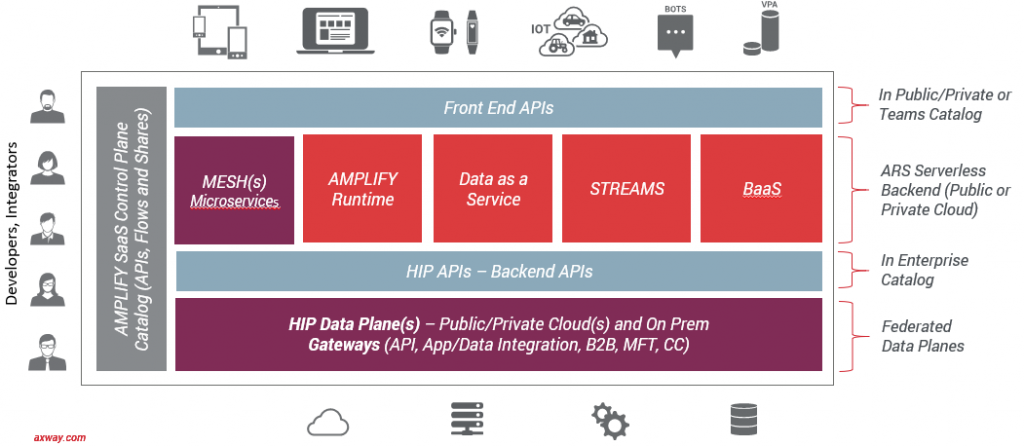The term API Platform has been used synonymously by some vendors with API Management, Full Lifecycle API Management, and even with the term API Gateway. Everyone loves to spice up a subject with the word platform, but being loose with the term is cutting the subject short. What is an API Platform? An API Platform is all these things and more.
An API Platform’s purpose is to serve net new application development — building new capabilities, new experiences, nurturing ecosystems, and more. API Management, Full Lifecycle API Management, and API Gateways are tables stakes here. These bring life to API design and development, to lifecycle management, to policy and security enforcement, to analytics, and to nurturing development communities as consumers of these APIs. All critical.
An API Platform is more. An API Platform becomes the complete back-end of digital serving developers to innovate faster and more efficiently, but also a way of operating through a common and managed catalog of services. Read five capabilities that every API Management Platform should have.
Two things to look at:
- The totality of services required to claim the complete back-end digital.
- The way of operating through a common catalog of services.
First a look at the table stakes—expanding on Full Lifecycle API Management. Enterprises are embracing APIs. These are the very foundation of modern integration and serving innovation and net new development. An API Platform embraces back-end APIs, published for the purpose of integration and then front-end APIs mediated, secured, and published to developers for front end experiences.
Mediation comes into play through a variety of capabilities to tailor APIs for front-end requirements. Mediation comes into play also to protect the back-end through security and usage policies, as well as provide instrumentation and analytics to performance, monitor threats and track SLAs.
The way of operating through a common catalog of services, gives one source of truth for all back-end and front-end APIs, with access and visibility managed for back-end integration teams, dev teams, and sometimes the public. It’s why universal API management is such an important foundation, and this way of operating extends well beyond a simple API Portal.
Let’s look at the totality of services beyond API Management that an API Platform brings development teams now operating through this catalog. APIs and API Management are critical and development teams building great experiences also require a robust set of back-end services to accelerate their work. These include:
- MESH microservices management
- Developer tools and API Mediation (not pictured)
- Runtime Services
- Data as a Service
- Streams/Event-Driven APIs
- Pre-Built back-end services
- Application Connectors
- And more
What is an API Platform?
Adding to that traditionally seen in Full Lifecycle API Management:
MESH and microservices management. Any transformative initiative will move beyond a great app and require back-end logic and capabilities to be developed. Dev teams will look towards modern microservice architectures. Packaged maturity for microservices, such as observability and API traffic management within the mesh, as well as Ingres and Egress from the mesh is key.
Developer Tools and API Mediation. Developer tools include low code tooling to create new APIs that run as microservices, to reduce or join APIs, to orchestrate flows across services. This allows development teams to build on back-end APIs and publish front-end APIs specific to front-end projects, mobile, IoT or otherwise.
Runtime Services: To move fast a serverless back-end that can spin up and down and scale dynamically is a must. This is essential for creations from dev teams—the containers and microservices, as well as the APIs built by dev teams to run them in a scalable infrastructure to support their front-end projects. Read more how Axway provides, as part of its Amplify platform, Runtime Services is an elastically scalable infrastructure (Container as a Service) that runs your applications.
Data as a Service: Front-end experiences may require a custom data store that needs to be quickly spun up and scalable, further, front end experiences can drive hundreds of millions of API calls per day to existing back-end databases and these need protection from the load. Data as a service as a layer in between systems is then often used as a buffer between enterprise back-end systems and the front end.
Data as a service provides scale to a legacy back end at a lower cost (via noSQL linear scale) and further can serve to reduce complexity and ensure availability for any front-end experience. LEARN MORE: Axway provides, as part of its Amplify platform, Mobile Backend Services and the cURL Firehose.
Streams/Event-Driven API: For applications where timing is critical, event-driven architecture is essential for real-time responsive user experience. An API Platform includes capabilities to turn any request-response API into an event-driven API to push data to subscribed clients efficiently and to protect the back-end from the common error of over polling. Learn more about how Amplify Streams enables you to augment your existing API infrastructure with an event-driven layer for publishing data from your APIs.
Pre-Built Backend Services: Commonly referred to as mBaaS from its mobile roots, any new experience will need to take advantage of common services including the likes of User management, Photos, Files, Places, Statuses, Check-ins, Posts, Events, Push Notifications and more. We are calling these Back-end Services as this goes beyond mobile.
Application Connectors: Intersecting with an API Platform is a full set of hybrid integration platform capabilities, connected through a catalog experience. Instantiate from iPaaS one or more of over 200+ application connectors that expose API endpoints to be consumed in your initiative.
Further leverage mappings to create a canonical API endpoint to update multiple systems of record in an API Call. Far more power comes from the openness of data through an API Platform part of an API enabled Hybrid Integration Platform strategy!

An API Platform is all about managing the full lifecycle of APIs and much more, to deliver innovative applications and experiences. An API Platform must be built on the premise of serving developer teams with the capabilities through a rich catalog with access and tooling for teams to act with autonomy and be successful in their endeavors.
We hinted about this, but what gets interesting is understanding the intersection with a Hybrid Integration Platform (HIP) and evolving integration strategies. An API Platform could be part of one’s HIP or separate—but an API Platform always intersects with one’s integration strategy.
Said another way, the real strength comes when one’s integration strategy aligns with and supports an API Platform approach to innovation and this is always the case with a properly implemented Hybrid Integration Platform (HIP) approach.
This gets to the fact that these are not separate “things”: they intersect and when looked at properly are two sides of the same coin! Looking at one side, you have an integration mindset, looking at the other an innovation mindset. Both cases serving developers and integrators through a multi-dimensional unified catalog through which they can act with autonomy and speed.
Bonus: API marketplaces as an essential component of the API platform
Read the ebook to modernize your IT infrastructure with APIs.

Follow us on social